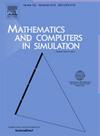Complex spatiotemporal dynamics in an eco-epidemic model: Turing instability, non-stationary patterns, and chaos control
IF 4.4
2区 数学
Q1 COMPUTER SCIENCE, INTERDISCIPLINARY APPLICATIONS
引用次数: 0
Abstract
This study presents the formulation of a spatiotemporal eco-epidemic model that takes into account an infectious disease affecting the prey population incorporating prey refugees and intraspecific competition of predators. In this work, we mainly focus on the interior equilibrium, which exists depending on the values of system parameters. In the absence of diffusion, our system shows rich dynamics, like Hopf bifurcation, chaos, etc. We analytically investigate the potential conditions for Turing instability in the context of diffusion. During numerical verification of our theoretical results, we see some non-stationary patterns along with the stationary pattern. By obtaining the Maximum Lyapunov exponent, we confirmed that the non-stationary pattern is chaotic. In addition, it is to be noted that maintaining ecosystem stability, preventing unpredictable population fluctuations, and ensuring the sustainability of species and resources all depend on controlling chaos in ecological models. For this purpose, we apply time-delay feedback control and successfully stabilize the spatiotemporal chaos.
生态流行病模型中的复杂时空动力学:图灵不稳定性、非平稳模式和混沌控制
本研究提出了一个时空生态流行病模型,该模型考虑了影响猎物种群的传染病,包括猎物难民和掠食者的种内竞争。在这项工作中,我们主要关注内部平衡,它的存在取决于系统参数的取值。在没有扩散的情况下,系统表现出丰富的动力学特性,如Hopf分岔、混沌等。我们分析研究了扩散条件下图灵不稳定性的潜在条件。在我们的理论结果的数值验证中,我们看到一些非平稳模式伴随着平稳模式。通过获得最大Lyapunov指数,我们证实了非平稳模式是混沌的。此外,需要注意的是,维持生态系统的稳定,防止不可预测的人口波动,确保物种和资源的可持续性,都依赖于控制生态模型中的混沌。为此,我们采用了时滞反馈控制,成功地稳定了时空混沌。
本文章由计算机程序翻译,如有差异,请以英文原文为准。
求助全文
约1分钟内获得全文
求助全文
来源期刊

Mathematics and Computers in Simulation
数学-计算机:跨学科应用
CiteScore
8.90
自引率
4.30%
发文量
335
审稿时长
54 days
期刊介绍:
The aim of the journal is to provide an international forum for the dissemination of up-to-date information in the fields of the mathematics and computers, in particular (but not exclusively) as they apply to the dynamics of systems, their simulation and scientific computation in general. Published material ranges from short, concise research papers to more general tutorial articles.
Mathematics and Computers in Simulation, published monthly, is the official organ of IMACS, the International Association for Mathematics and Computers in Simulation (Formerly AICA). This Association, founded in 1955 and legally incorporated in 1956 is a member of FIACC (the Five International Associations Coordinating Committee), together with IFIP, IFAV, IFORS and IMEKO.
Topics covered by the journal include mathematical tools in:
•The foundations of systems modelling
•Numerical analysis and the development of algorithms for simulation
They also include considerations about computer hardware for simulation and about special software and compilers.
The journal also publishes articles concerned with specific applications of modelling and simulation in science and engineering, with relevant applied mathematics, the general philosophy of systems simulation, and their impact on disciplinary and interdisciplinary research.
The journal includes a Book Review section -- and a "News on IMACS" section that contains a Calendar of future Conferences/Events and other information about the Association.
 求助内容:
求助内容: 应助结果提醒方式:
应助结果提醒方式:


